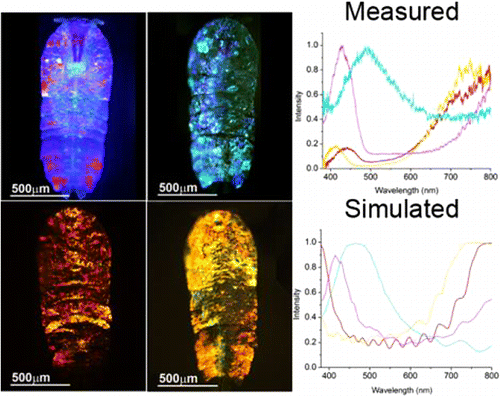The secret to the sea sapphire's colors—and invisibility

Sapphirina, or sea sapphire, has been called "the most beautiful animal you've never seen," and it could be one of the most magical. Some of the tiny, little-known copepods appear to flash in and out of brilliantly colored blue, violet or red existence. Now scientists are figuring out the trick to their hues and their invisibility. The findings appear in the Journal of the American Chemical Society and could inspire the next generation of optical technologies.
Copepods are tiny aquatic crustaceans that live in both fresh and salt water. Some males of the ocean-dwelling Sapphirina genus display striking, iridescent colors that scientists think play a role in communication and mate recognition. The shimmering animals' colors result when light bounces off of the thin, hexagonal crystal plates that cover their backs. These plates also help them vanish, if only fleetingly. Scientists didn't know specifically what factors contributed to creating different shades. Scientists at the Weizmann Institute and the Interuniversity Institute for Marine Sciences in Eilat wanted to investigate the matter.
The researchers measured the light reflectance—which determines color—of live Sapphirina males and the spacing between crystal layers. They found that changes of reflectance depended on the thickness of the spacing. And for at least one particular species, when light hits an animal at a 45-degree angle, reflectance shifts out of the visible light range and into the ultraviolet, and it practically disappears. Their results could help inform the design of artificial photonic crystal structures, which have many potential uses in reflective coatings, optical mirrors and optical displays.
More information: Structural Basis for the Brilliant Colors of the Sapphirinid Copepods J. Am. Chem. Soc., 2015, 137 (26), pp 8408–8411. DOI: 10.1021/jacs.5b05289
Abstract
Males of sapphirinid copepods use regularly alternating layers of hexagonal-shaped guanine crystals and cytoplasm to produce spectacular structural colors. In order to understand the mechanism by which the different colors are produced, we measured the reflectance of live individuals and then characterized the organization of the crystals and the cytoplasm layers in the same individuals using cryo-SEM. On the basis of these measurements, we calculated the expected reflectance spectra and found that they are strikingly similar to the measured ones. We show that variations in the cytoplasm layer thickness are mainly responsible for the different reflected colors and also that the copepod color strongly depends on the angular orientation relative to the incident light, which can account for its appearance and disappearance during spiral swimming in the natural habitat.
Journal information: Journal of the American Chemical Society
Provided by American Chemical Society





















